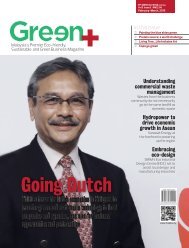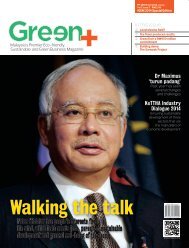Green+ Malaysia's Premier Eco-friendly, Sustainable and Green Business Magazine
SIRIM - Technology Provider
SIRIM - Technology Provider
Create successful ePaper yourself
Turn your PDF publications into a flip-book with our unique Google optimized e-Paper software.
ENVIRONMENT<br />
National Park,<br />
Terengganu.<br />
2. Self Regulatory<br />
Through the provision of Section 49A,<br />
such as a competent person <strong>and</strong> special<br />
provisions under the Environmental<br />
Quality (Scheduled Wastes) Regulations<br />
2005, Environmental Quality (Sewage)<br />
Regulations 2009, Environmental<br />
Quality (Industrial Effluents)<br />
Regulations 2009 <strong>and</strong> Environmental<br />
Quality (Clean Air) Regulations 2014,<br />
the developers <strong>and</strong> industry players<br />
need to self - monitor their own process<br />
activities <strong>and</strong> management of<br />
the waste so that its complies with the<br />
requirement under EQA. Each <strong>and</strong> every<br />
industry or project needs to have dedicated<br />
competent persons (recognized<br />
by the Department of Environment<br />
(DOE) through certification programs)<br />
that will be responsible in environmental<br />
management of industrial involved<br />
segment of scheduled wastes, water<br />
<strong>and</strong> air as to ensure compliance with<br />
the st<strong>and</strong>ards set limits <strong>and</strong> without<br />
the need for regular inspections<br />
by the DOE. This indirectly also optimizes<br />
the use of resources, whether in<br />
the industry or DOE. Self-monitoring<br />
<strong>and</strong> self-reporting by industrial sectors<br />
also involved the use of applications<br />
system such as continuous emission<br />
monitoring system (CEMS) for monitoring<br />
of emissions to air in real time;<br />
electronic consignment note (E-CN) for<br />
monitoring the production, movement<br />
<strong>and</strong> disposal of scheduled wastes; <strong>and</strong><br />
monthly discharge monitoring report<br />
(MDMR ) for effluent discharge monitoring<br />
<strong>and</strong> reporting. Performance<br />
monitoring aspects on pollution control<br />
equipment whether water or air is also<br />
applied in respect of self-regulatory<br />
program. This is to enable the industry<br />
to monitor <strong>and</strong> ensure that pollution<br />
control equipment operates optimally<br />
at all times, thereby ensuring compliance<br />
with emissions or discharges limit.<br />
3. Continuous revision of the environmental<br />
rules <strong>and</strong> regulations<br />
Revisions, amendments <strong>and</strong> development<br />
of regulations under the<br />
Environmental Quality Act 1974 also<br />
made holistic so that it is more comprehensive,<br />
effective <strong>and</strong> consistent with<br />
the current technology (best available<br />
techniques economically achievable).<br />
Studies also made before any<br />
regulations enacted or amended to<br />
enable DOE to assess whether limits<br />
or st<strong>and</strong>ards can be achieved by the<br />
industry in line with the availability<br />
of technology or technology-related<br />
changes related to pollution control. In<br />
addition, the stakeholder’s consultation<br />
Paya Indah<br />
Wetl<strong>and</strong>s.<br />
The river water quality<br />
information provided from<br />
monitoring program will assist<br />
the enforcement in many<br />
ways such as identifying<br />
possible polluter, assessing<br />
their effectiveness <strong>and</strong> helping<br />
in strategizing stronger<br />
enforcement in the future.<br />
was also held to obtain feedback from<br />
stakeholders in the industry to enable<br />
compliance with the prescribed limits<br />
or st<strong>and</strong>ards can be achieved (achievable)<br />
<strong>and</strong> can be effectively enforced<br />
by the DOE (enforceable) <strong>and</strong> to protect<br />
public health <strong>and</strong> safety.<br />
4. Internal Control<br />
In addition to the setting rules <strong>and</strong> limits<br />
or st<strong>and</strong>ards under the Environmental<br />
Quality Act 1974, the DOE also improve,<br />
update <strong>and</strong> provide training on internal<br />
work procedures or St<strong>and</strong>ard Operating<br />
Procedures (SOPs). The DOE given priority<br />
<strong>and</strong> emphasis on investigation<br />
of the repeated complaints cases <strong>and</strong><br />
emergency cases related to pollution,<br />
especially those involving the interests<br />
of public health <strong>and</strong> safety including<br />
illegal dumping of scheduled waste,<br />
illegal discharges into river <strong>and</strong> open<br />
burning. Continuous monitoring <strong>and</strong><br />
enforcement of the sources of pollution<br />
made through early detection approach<br />
such as Pollution Sources Survey<br />
(PSS). Enforcement is also through the<br />
involvement of public which involves<br />
active participant from Rakan Alam<br />
Sekitar (RAS) which is called Pollution<br />
Monitoring Team (Pasukan Pemantau<br />
Pencemaran - 3P).<br />
ENHANCING WATER QUALITY<br />
An essential part in enhancing water<br />
quality is river quality monitoring.<br />
Consistent <strong>and</strong> long-term monitoring<br />
strategies will provide valuable information<br />
on pollutants content levels<br />
in rivers. Such information helps to<br />
strengthened enforcement activities<br />
apart from shaping our future development<br />
planning while preserving river<br />
water quality at its best state.<br />
“Currently, DOE is implementing<br />
the river water quality monitoring<br />
through its 891 manual stations <strong>and</strong> 10<br />
automatic stations covering 477 rivers<br />
within 140 identified river basins. Fiftyfive<br />
of the manual stations have been<br />
set up to monitor river water quality at<br />
upstream of selected raw water intake<br />
for domestic raw water treatment<br />
plants.<br />
“DOE will continue to step up its<br />
enforcement on pollution sources <strong>and</strong><br />
industries discharging effluents into<br />
rivers to ensure all related legal requirements<br />
stated in Environmental Quality<br />
Act, 1974 were successfully complied<br />
with.<br />
”The river water quality information<br />
provided from monitoring<br />
program will assist the enforcement<br />
in many ways such as identifying<br />
possible polluter, assessing their effectiveness<br />
<strong>and</strong> helping in strategizing<br />
green+.2014, november-december 13





